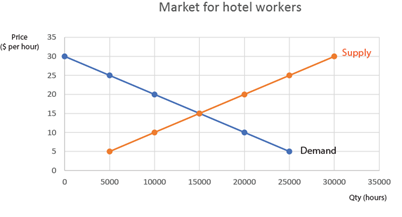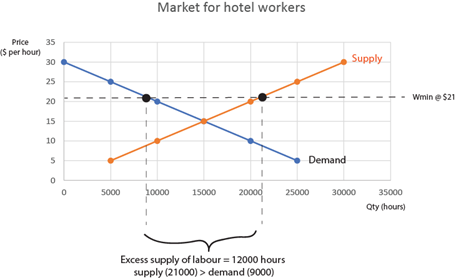Application Exercise 7a


- If the minimum wage was set to $21 per hour then it would create excess supply in the labour market (i.e. unemployment). This occurs because a higher wage encourages more people to enter the labour market in search of employment (i.e. it increases supply) and employers are encouraged to reduce their demand for labour (e.g. substituting labour for capital). This means that the minimum wage will force the market to operate at a position of disequilibrium, where the demand for labour remains below the supply of labour. This disequilibrium position of excess supply is illustrated in the diagram below where the $21 minimum wage leads to an excess supply of labour of approximately 12,000 hours.

The following hypothetical scenarios assume that no minimum wage exists in the market for hotel workers:
- The introduction of labour saving technology (such as an automated concierge desk) is likely to reduce the demand for labour (reflected in a shift of the demand curve to the left) because hotels no longer require personnel to staff a concierge desk. The new equilibrium position will be one where wages and employment will be lower than before.
- A reduction in consumer confidence is likely to negatively impact on aggregate demand and real GDP in the economy. This will reduce the demand for labour because businesses will be producing fewer goods and services than before, leading to a reduction in the demand for resources such as labour. The new equilibrium position will be one where wages and employment will be lower than before.
- This type of business strategy has the potential to incentivize effort within the industry and therefore contribute to an increase in labour productivity. This effectively makes labour more valuable than before and results in an increased demand for labour (reflected by a shift of the demand curve to the right). The new equilibrium position will be one where wages and employment will be higher than before.
- This relates to changes in relative prices – in this case a change in the relative price of labour. If ALDI offers more attractive rates of pay, then it encourages workers in other industries or sectors, such as those in the hospitality sector (including hotels), to chase the higher rates of pay on offer at ALDI. This results in a decreased supply of labour in the market for hotel workers and leads to a shortage of workers in this market.
- Growth in Airbnb will reduce the demand for labour (reflected in a shift of the demand curve to the left) because hotels will suffer a drop in demand, leading to a reduction in the demand for resources such as labour. The new equilibrium position will be one where wages and employment will be lower than before.
- This is similar to the explanation relating to ALDI offering higher wages. As more workers will be encouraged to offer their labour services in the digital economy, it results in a decreased supply of labour in the market for hotel workers and leads to a shortage of workers in this market. Hotels will need to increase the wage on offer in order to attract (or retain) hotel workers. As the wage for hotel workers increases over time, this will restore equilibrium as hotels will be encouraged to reduce the demand for labour (reflected by a contraction along the demand curve) and more labour will be attracted to hotels by the higher wages on offer.
- The ageing population will reduce the supply of labour to a whole host of industries, including the hotel industry. This will be reflected by the supply curve shifting to the left as workers retire and exit the labour force. Hotels will need to increase the wage on offer in order to attract (or retain) hotel workers. As before, the new equilibrium position will be one where wages are higher and employment is lower than before.
